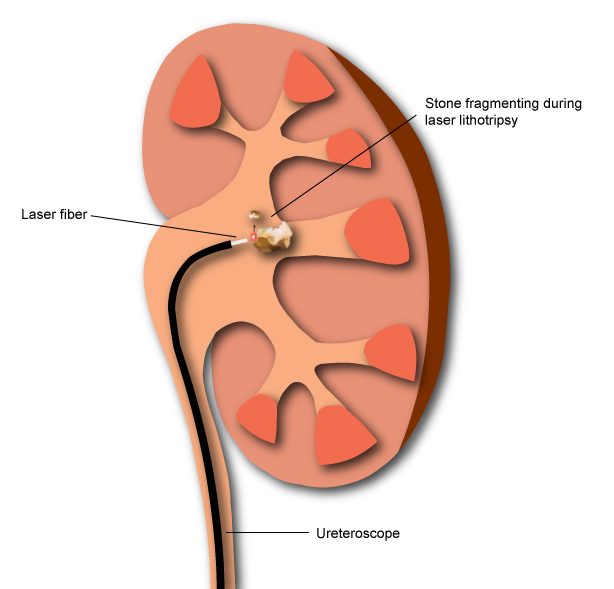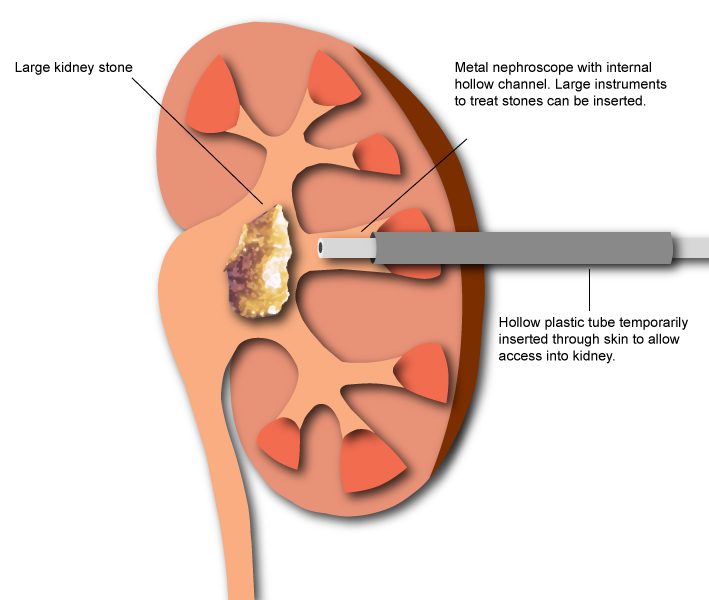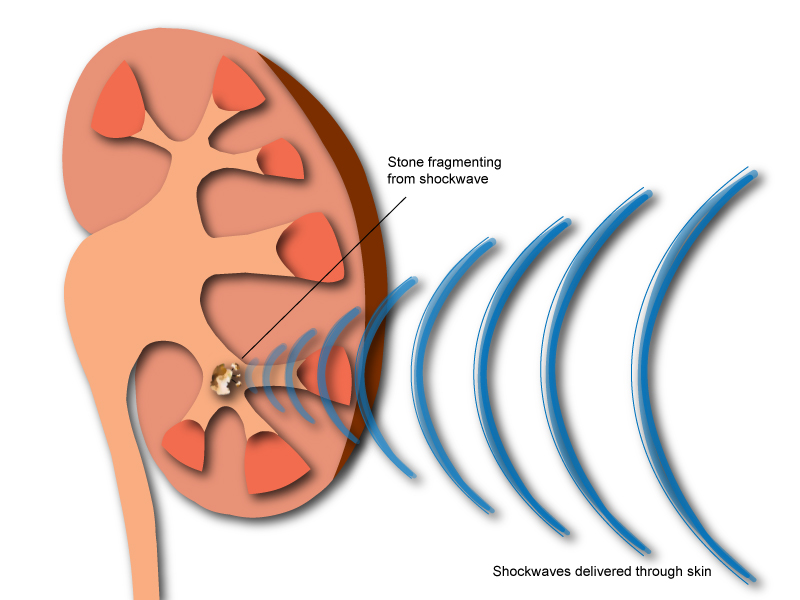Surgical Options for Removing Kidney Stones
Understanding what is the best option for treating your kidney stone can be difficult. Learn more as we summarize the various surgical options available. While it still won’t make the decision for you, it can help you to make an informed decision when talking to your urologist.

Ureteroscopy
Ureteroscopy is the most common surgical intervention for kidney stones. It involves the use of a small flexible or rigid device called a ureteroscope to directly see and treat stones with a laser. The ureteroscope, which provides a video image and has small “working” channels, is inserted into the bladder and up to the ureter until the stone is encountered. The stone can then either be broken up with a laser fiber or pulled out using small baskets that are inserted into the working channels. The advantage of this type of surgery is that the body’s normal openings are used and no incisions are necessary. A photo of a flexible ureteroscope and a video of ureteroscopy with laser lithotripsy is shown below.
Ureteroscopy often a good option for small stones and mid sized stones in the ureter or kidney. Its success rate at clearing these types of stones is generally higher than that for ESWL.
Compared with shockwave lithotripsy however, it may associated with increased discomfort after surgery, especially when a stent is required. For stones too big for ureteroscopy sometimes a percutaneous approach may be preferable.
Fast Facts About Ureteroscopy:
- Typical operative time: 1-2 hours
- Usual hospital stay: Ureteroscopy is an outpatient procedure
- Average number of days before going back to work: 1-3 days
- Average number of days before feeling back to normal: about 4-7 days (varies based on use of a ureteral stent)

Percutaneous Nephrolithotomy (PCNL)
Percutaneous (PCNL) stone surgery is often used for larger stones or modest size stones when patients are looking to avoid ureteroscopy. PCNL is the approach that has the highest success in terms of removing all stones. A small 1 inch incision is made on the patients back, and with gentle dilation of a track, direct access into the kidney is made and a sheath (see picture below) is placed to allow instruments to be moved in and out. The newest lithotripters use electromagnetic jackhammers, ultrasound waves and suction to fragment and remove all stones. There are 2 main sizes of PCNL telescopes that can be used, a standard for larger stones and a mini can be used for smaller stones.
Fast Facts About Percutaneous Nephrolithotripsy:
- Typical operative time: 1-2 hours
- Usual hospital stay: 0-1 day.
- Some centers now send patients home same day
- Some centers utilize a block to numb the area around the kidney, significantly reducing pain.
- Average number of days before going back to work: 3-7 days
- Average number of days before feeling back to normal: about one week

Shockwave Lithotripsy (ESWL)
Extracorporeal shockwave lithotripsy uses focused sound waves to breakup your stones from outside your body. The advantage of this treatment approach is that instruments may not need to be introduced into your body (unless your stone is large, in which case a stent is usually placed at the time of surgery).
ESWL may be associated with less discomfort than other treatment options such as ureteroscopy or percutaneous nephrolithotripsy. However, ESWL does not usually have as high of a success rate as these other surgical treatment options and is more likely to require re-treatments. Furthermore, ESWL can only focus on 1 stone at a time, meaning if you have multiple stones, or stones in each kidney, ESWL can only treat 1 of those stones per session.
ESWL is easier to perform for stones that are visible on plain x-rays because this type of x-ray is used to target the stones during treatment. For stones that are not visible on plain x-ray, such as uric acid stones, special techniques can be used to allow ESWL to still be used. Stones that are less dense (which can be measured from CT scans) tend to respond better to ESWL than stones that are more dense.
ESWL can be used to treat both stones in the kidney and stones in the ureter. ESWL may not be as effective in patients who are obese because the increased body tissue can make it more difficult to visualize or treat stones.
Fast Facts About ESWL:
- Typical operative time: 1/2 hour
- Usual hospital stay: No hospital stay, ESWL is outpatient surgery.
- Average number of days before going back to work: 1-3 days
- Average number of days before feeling back to normal: 4-7 days

Research Articles
Stay Involved
Nearly 10% of the United States population has suffered from stones. You can help connect with our community and support our mission to accelerate kidney stone research.
Complete the form to learn more about KSC and its initiatives.
By submitting this form, you consent to receive educational emails, research updates, and event invitations from Kidney Stone Collaborative. We will never sell or share your information with third parties. You may unsubscribe at any time.
Information provided is for educational purposes only and is not a substitute for medical advice. Please consult a qualified healthcare professional for personal medical concerns.

